Let’s delve into the fascinating world of hummingbird mating and unravel the mysteries behind their breeding habits. We will explore how and when these enchanting creatures engage in courtship rituals, shedding light on their remarkable reproductive behaviors.
Courtship Behaviors of Different Hummingbird Species

There are 350 species of hummingbirds.
©Wang LiQiang/Shutterstock.com
Hummingbird courtship behaviors vary depending on the species. Most of them involve fancy diving and making a sound with their tail feathers.
When male hummingbirds want to catch the attention of a female, they know how to put on an impressive show. They don’t just sing or flutter their tail feathers. They perform an elaborate courtship dive that is faster than most bird behaviors and thus hard to capture on film. A potentially dangerous maneuver, it is the perfect way for male birds to demonstrate their bravery and skill. Hummingbird courtship dives are truly a spectacle to behold.
Different Hummingbird Mating Rituals
Rufous hummingbirds display courtship behaviors that involve the male hovering in front of the female while singing (with his tail feathers) and displaying his vivid colors. The female will then choose the male she finds most attractive.
Ruby-throated hummingbirds engage in courtship behaviors in which the male will fly high into the air and then dive downwards in a U-shape. All while singing and displaying his dazzling feathers.
Broad-tailed hummingbirds display courtship behaviors that involve the male flying in circles and then diving to the ground while his tail feathers sing and make a brilliant show.
Anna’s hummingbirds display courtship behaviors that involve the male flying in what scientists have named a “J-dive.” Who wouldn’t be impressed by that?
In all hummingbird species, the male’s courtship behavior is designed to show off his vivid feathers and his ability to fly swiftly. Some types of hummingbirds, like the Rufous and broad-tailed, even have tail feathers designed for fancy diving maneuvers to impress their ladies. Costa’s hummingbirds know how to twist their tailfeathers to increase the sound they are making for an even more impressive display.
When Does Courtship Take Place?
Once breeding season approaches, the males arrive to start courting. The timing of their arrival is based on the type of hummingbird. In general, the mating season starts in spring. It appears that these birds are not faithful to one partner, and males often pursue multiple mates during this period. They perform a variety of dives to attract potential mates, which can last up to 10-12 seconds, although this varies depending on the species. As fast-moving migratory birds, it’s no surprise that hummingbirds execute their dives with lightning speed.
How to Identify a Male or Female Hummingbird
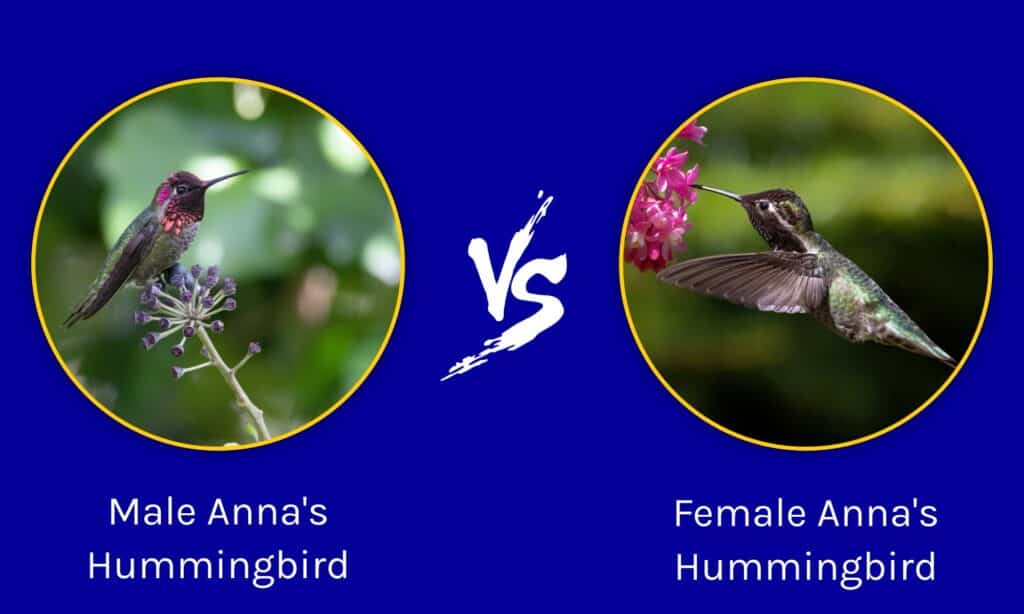
Hummingbirds are a beautiful and fascinating species of bird, and correctly identifying a male or female hummingbird can be a delightful challenge. Here are a few tips on how to do so.
First, observe the hummingbird for its coloration. Male hummingbirds typically have bright, iridescent colors on their throats, heads, and chests. Females have duller and more muted colors and often have streaks or spots on their throats.
Second, listen to the bird’s call. Male hummingbirds sing a complex, high-pitched song to attract mates and defend their territories. Females also sing, but their songs tend to be shorter and less complex.
Thirdly, it is possible to tell the difference between males and females by looking at their physical features. Generally, male hummingbirds have plain-colored tail feathers without any markings. Whereas female hummingbirds usually have white spots on the tips of their tail feathers. Young male hummingbirds in their first season have the same coloring as adult females. This helps protect them from predators and other competitors.
Finally, observe the hummingbird’s behavior. Male hummingbirds are often more aggressive and territorial than females. They will often chase away other birds and are quick to defend a food source. Females are generally more docile and tolerant of other birds.
By taking the time to observe the physical characteristics, behavior, and vocalizations of a hummingbird, you can accurately identify whether it is a male or female. With a little practice, you’ll be able to identify hummingbirds with ease.
Nest Building
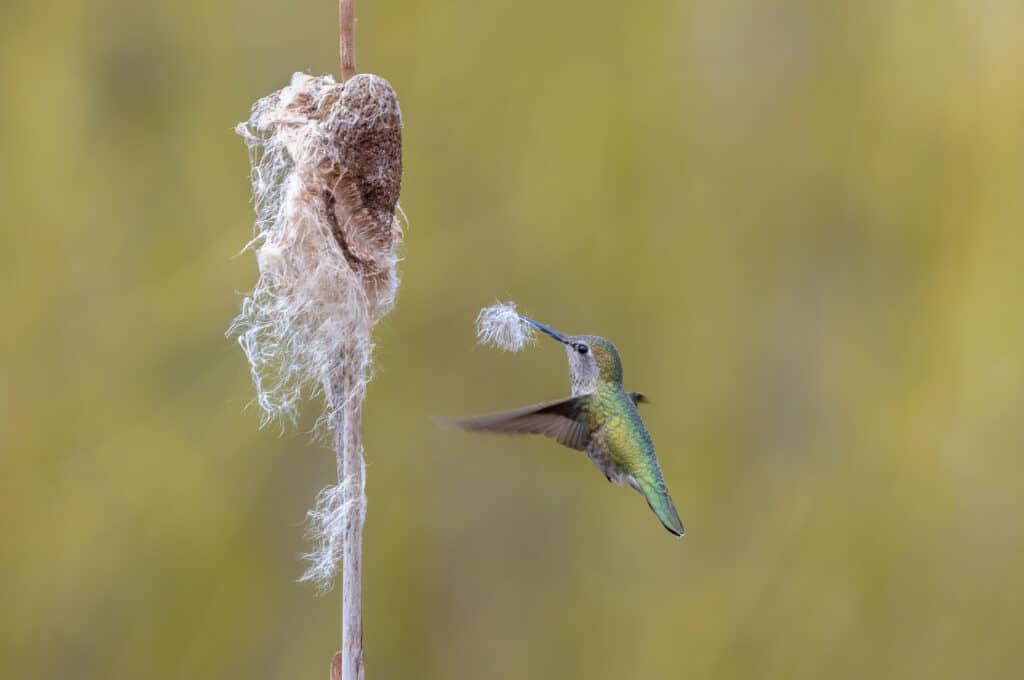
The female hummingbird collects all nesting material and builds the nest.
©Devonyu /Shutterstock.com
If you spot a hummingbird making frequent trips to one spot, hopping up and down on a perch, displaying peculiar behavior while carrying items in its beak, it’s likely a female constructing her nest. Similarly, if a hummingbird is devotedly sitting on its nest during the day, tending to young ones and bringing food back to the nest, then it is probably a mother taking care of her offspring. In the hummingbird realm, the female alone is responsible for preparing the nest and raising the babies.
After mating with the male, the female starts counting down the time until she builds her nest. During this time, her eggs are developing while she looks for the perfect spot to construct her nest and frantically gathers the necessary materials. She looks for a nesting area that is protected from harsh weather conditions like wind, rain, and temperature changes. To make her nest, she uses materials such as lichen, moss, and small twigs that help it blend into its surroundings. Spider silk is used to stick all the components together, forming a cup-like structure.
As the baby hummingbirds develop, their mother often reinforces the nest to ensure it is secure enough for them as they grow quickly. The mom hummingbirds put a lot of effort into their nests since their babies must stay safely tucked away in them for 5-8 weeks. Plenty of food close to the nest is very important for mating and raising young, as feeding themselves and their babies is essential.
Hummingbird Mating
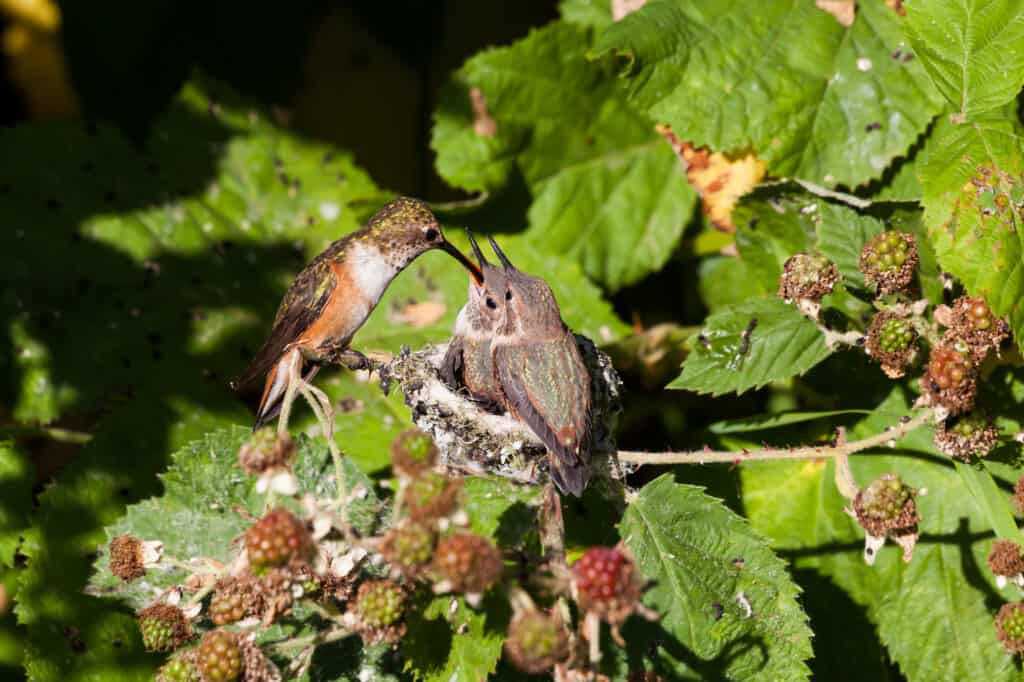
You have to be fast to see hummingbird mating. It typically lasts three to five seconds.
©Feng Yu/Shutterstock.com
Humans have to be quick to learn about the mating habits of hummingbirds. The entire process only lasts a few seconds. Unlike humans, male hummingbirds do not possess an external penis and therefore do not engage in sexual penetration. Instead, sperm is passed between the two birds when the male presses his cloaca (back opening) against the female’s. This allows for fertilization of the female’s eggs.
Hummingbirds may look like they mate in the air, but in reality, they use perches to join together. Females will wait on a branch before a male mounts her from behind for a few seconds. Once the mating process is complete, the birds go their separate ways, and the male searches for another partner while the female builds her nest.
How Big Are Hummingbird Eggs?
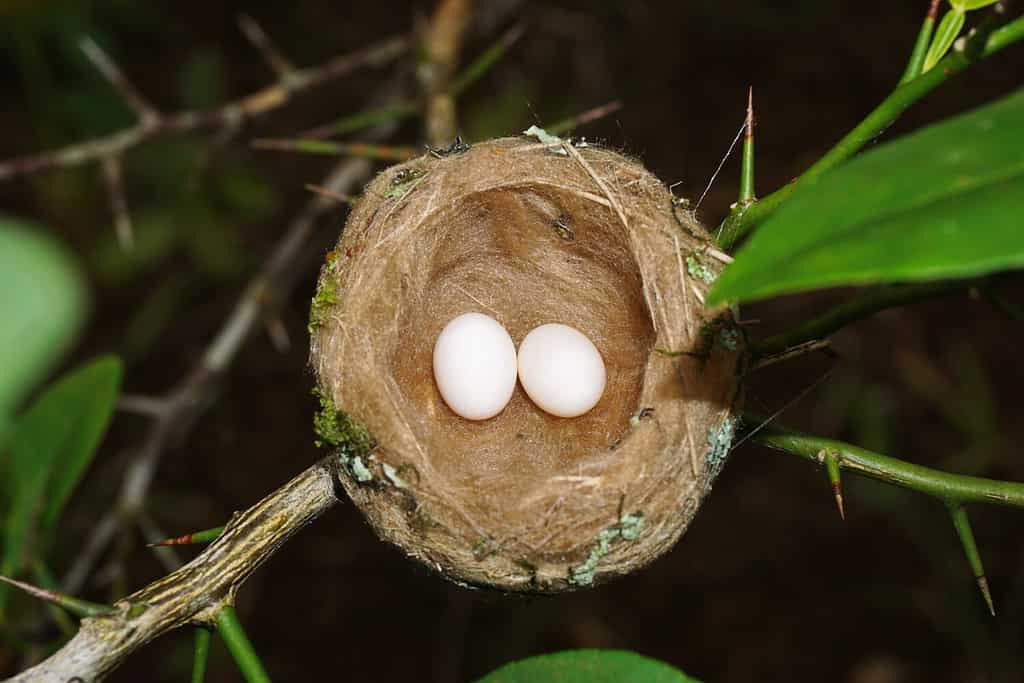
The eggs of hummingbirds are usually around the size of a jellybean.
©Damsea/Shutterstock.com
Hummingbird eggs are incredibly small and typically likened to jelly beans. Depending on the species, they can range from the size of a coffee bean to the size of a penny. The lightest hummingbird egg is the Ruby-throated Hummingbird egg, which weighs around one-fifth the weight of a penny.
The smallest species of hummingbird is the Bee Hummingbird found in Cuba, and the largest is the Giant Hummingbird found in the Andes, which can measure up to nine inches long and weigh more than a Barn Swallow.
Hummingbirds lay small batches of eggs – generally between one and three – but two is the average. Despite their tiny size, the eggs are quite large when you consider the size of adult hummingbirds. To compare, a robin egg is 3.5 percent of the weight of the adult bird, whereas a ruby-throated Hummingbird egg is over 16 percent of the weight of its parent.
How Often Do Hummingbirds Have Babies?
Most hummingbird species lay eggs one to three times a year. Anna’s Hummingbirds, found on the Pacific Coast, usually have two or three broods yearly, as do some non-migratory hummingbirds in the tropics. Ruby-throated Hummingbirds, which migrate annually, typically only have one brood. However, if the nest is destroyed early in the breeding season, females may build another and lay more eggs.
Hummingbird Mating — Time of Year

The most common time of year for hummingbird mating is spring.
©Agnieszka Bacal/Shutterstock.com
The timing of when hummingbirds lay their eggs can vary depending on where they are located. For example, the Ruby-throated Hummingbird, which is only found in the eastern United States, generally lays eggs between March and May.
On the other hand, Costa’s Hummingbird, which is in the Southwest, usually lays eggs between mid-February to early June. Rufous Hummingbirds, who live and mate in the Pacific Northwest, Canada, and Alaska, tend to lay their eggs later in the year, usually between late April and July. The exact date may depend on a variety of factors, such as latitude and travel time.
Hummingbird Mating — Egg Incubation

The mother hummingbird builds her nest from moss, spider webs, and any other soft materials she can find.
©Daniel Lamborn/Shutterstock.com
A certain amount of incubation is necessary for hummingbird chicks to hatch, and this can last between two to three weeks. Females have to take on the burden of both keeping the eggs warm and supplying food for themselves, which is a difficult task. Especially since they need to eat every 10-15 minutes! Black-chinned Hummingbirds in California have to make frequent trips in order to get food, usually going out six to nine times each hour. In more temperate climates, females are able to leave their nests for longer periods of time, and the task is less arduous.
Don’t Touch the Nest!
If you are fortunate enough to witness hummingbird eggs, it is advisable to observe them from a distance with binoculars rather than getting too close. It is illegal in the U.S. to handle, move, or take away any active nests. Additionally, your presence can cause undue stress for the female hummingbirds and may forewarn predators, such as stellar jays, to the nest’s whereabouts. For these reasons, it is best to stay away from hummingbird nests, no matter how tempting it may be to take a picture!
Hummingbird Mating — New Chicks
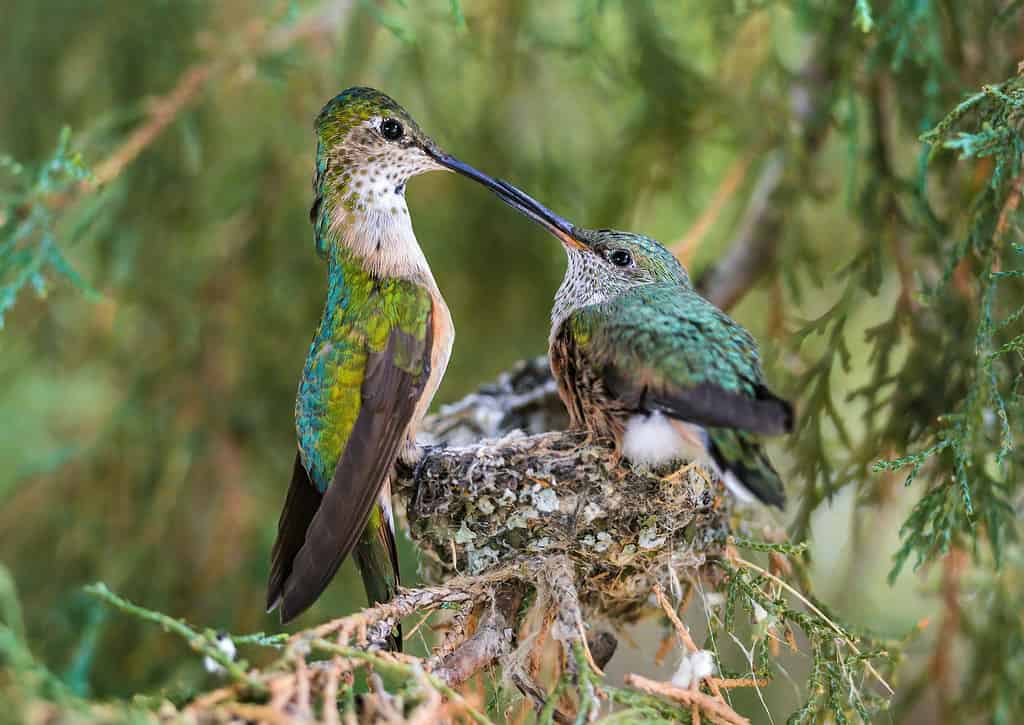
Feeding new hatchlings is a lot of work. They need to eat many times per hour!
©Susan Hodgson/Shutterstock.com
Newly hatched hummingbirds are referred to as nestlings, chicks, or hatchlings. They come out of their shells without feathers and with their eyes closed, unable to stand. They are incredibly tiny and helpless, needing their mother for food and warmth. At around three weeks old, they will have grown a full set of feathers ready for their first flight.
At a young age, hummingbird chicks are able to take to the skies and fly away from their nest. In a period of one to two months, they are prepared to start their initial flight, a process known as fledging. Once they have fledged, they are independent and ready to migrate if necessary.
What Do Hummingbird Hatchlings Eat?

When it comes to hummingbird mating, the mama bird takes on the job of raising the young alone.
©iStock.com/Sen Yang
Young hummingbirds require a diet that is high in protein and consists of insects in order to grow quickly and develop strong bones and beaks. Additionally, they need nectar for their energy needs. The mother hummingbird will look for food multiple times a day and feed the chicks by regurgitating food into their mouths, an action that resembles sword swallowing. She will keep feeding them until they are almost one month old, or as long as 60 days for certain tropical species. After this time, the hatchlings must start to feed themselves.
The photo featured at the top of this post is © Fiona M. Donnelly/Shutterstock.com
Thank you for reading! Have some feedback for us? Contact the AZ Animals editorial team.







